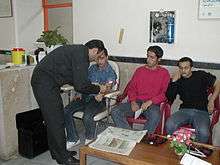Maziar Ashrafian Bonab


Dr. Maziar Ashrafian Bonab (Persian: مازیار اشرفیان بناب) is an Iranian Forensic and Medical Geneticist/specialised in forensic genetics[1] (the use of the DNA markers in the investigation of crimes and ancestry) and Forensic Facial Reconstruction. His groundbreaking research uses human DNA markers (mainly mtDNA and the Y chromosome markers) to identify the ancestral history of humans/human populations in both anthropological and forensic cases. His main area of research is the population history of the Middle East, specifically Iran.
Maziar was born in Tehran, Iran (20 September 1966). Before completing his PhD in Cambridge, he first qualified as a Medical Doctor from Tehran University of Medical Sciences (1984–1991) and worked as a Medical Practitioner in Iran. After completing a postgraduate course in Forensic Medicine at the Iranian Legal Medical Organization (1992), he worked as the head of Hormozgan Province Legal medical Centre (Iran) for four years (1992–1996). As well as dealing with many different forensic cases and having done more than 400 autopsies, he taught forensic medicine and medical anthropology to the undergraduate and postgraduate degree programmes within the Bandar-Abbas University of Medical Sciences and Bandar-Abbas Islamic Azad University.
Since 1996 to 2002, he worked as an academic member of the Iranian Archaeological Research Centre at the Cultural Heritage Organization of Iran (ICHO) - and as a forensic anthropologist he participated in seventeen archaeological excavations around Iran.[2]
At the same time as the founder and head of The National Museum of Medical Sciences History (Iran), he established the first medical museum in the country and the largest one in the Middle East. In 2003 he completed an MSc degree in Archaeology (2002–2003) at the Department of Biomolecular Sciences; University of Manchester Institute of Science and Technology and in October 2003 he started a PhD in the field of biological anthropology/human population genetics at the University of Cambridge. Since 2006 He has been working as a Senior Lecturer at the School of Biological Sciences; University of Portsmouth. .[3] He has published various books and papers on his research. In his current research he is using genetic tools to investigate the maternal and paternal history of the Iranian ethnic groups, and also the emergence of first farmers in the Iranian Plateau (eastern parts of the Fertile Crescent) and the origin of Aryans (Indo-Iranians) and Indo-Aryan race theory.
Published works
- Essentials of Forensic Medicine; ISBN 964-456-511-8.
- Skull Operation, Ancient Style; The Circle of Ancient Iranian Studies.
- "Is urbanization scrambling the genetic structure of human populations? A case study.". Heredity (Edinb). 98 (3): 151–6. Mar 2007. doi:10.1038/sj.hdy.6800918. PMC 1808191
 . PMID 17106453.
. PMID 17106453. - Distribution of killer cell immunoglobulin-like receptors (KIR) and their HLA-C ligands in two Iranian populations; http://www.springerlink.com/content/656v255t30k8802h/
- Geographical Structure of the Y-chromosomal Genetic Landscape of the Levant: A coastal-inland contrast; http://onlinelibrary.wiley.com/doi/10.1111/j.1469-1809.2009.00538.x/abstract
- Influences of history, geography, and religion on genetic structure: the Maronites in Lebanon; http://www.nature.com/ejhg/journal/vaop/ncurrent/full/ejhg2010177a.html
- Afghanistan's Ethnic Groups Share a Y-Chromosomal Heritage Structured by Historical Events; http://www.plosone.org/article/info%3Adoi%2F10.1371%2Fjournal.pone.0034288
References
- ↑ سرويس: / پژوهشي / شماره خبر:. ISNA (in Persian). 06-12-2006. Retrieved 27 June 2012. Check date values in:
|date=(help) - ↑ Persian
- ↑
External links
- Azad University
- Persian at the University of Wisconsin
- University of Cambridge, Department of Genetics
- University of Portsmouth; School of Biological Sciences
- Irangenome
- "Is urbanization scrambling the genetic structure of human populations? A case study.". Heredity (Edinb). 98 (3): 151–6. Mar 2007. doi:10.1038/sj.hdy.6800918. PMC 1808191
 . PMID 17106453.
. PMID 17106453.